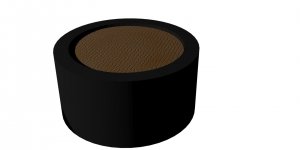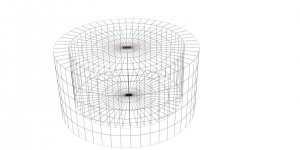Ok, the proverbial cat is out of the bag.
Some of you out there already know and have had the opportunity to shoot with my low deflection tip. YES, you heard that correctly, it is a tip that makes any shaft low deflection.
The official launch will be in ~1 to 2 months.
My original intent was not to create a low deflection tip although I had suspected that the potential for the tip to reduce squirt was there.
I had spoken about it with Royce and like most people, he believed that a reduction in end mass was the only thing that could reduce cueball squirt.
I had accepted that and it took me a minute after testing the first prototype to even realize what had happened.
As many of you probably know from my past posts, I was a huge adherent to BHE. So much so in fact that I had begun to mark (with a sharpie) the pivot points on my non-LD shafts and cues.
It was one of those shafts that I had put my tip onto and during initial test trials, I kept missing shots while using BHE.
Then it dawned on me that I had suspected that reduced squirt could be a consequence of the design and I switched to not adjusting my aim for squirt and I started making everything.
That's where it all began.
Initially, I had two purposes in mind when I designed my tips. To eliminate mushrooming and to increase energy transfer on center ball hits.
I'll be offering two types of tips, a low deflection tip and a hybrid tip. Actually, both tips will be low deflection but one will be a true hybrid with a harder denser material in the center of the tip to promote better energy transfer where miscues are impossible and one will be more traditional with the encapsulation that allows it to reduce squirt.
I'm in the process of setting up the production facility and the website, so they are not quite ready to launch but they will be soon.
As some of you know, I travel a lot in my main career as a fiber optic network field engineer and that has given me the opportunity to show some AZers and pool players the prototypes of the tips and allow them to hit some balls with them.
The feedback from those that have hit with them has been entirely positive.
I'm willing to answer questions, but I do ask that we keep it cordial. I'm not looking to get into a bunch of arguments although I do understand that any time that results fly in the face of believed paradigms, there is resistance. That's why I've decided to send Dr. Dave a free tip for peer review. I'll be sending him one here in the next week or so, but Dave has said that it may be a while before he has a chance to doing any tests and that's no problem.
I'm confident enough in the results I have found that I'm sure that he will come to the same conclusion on the results even if we don't end up agreeing on the underlying mechanisms involved.
Jaden
Some of you out there already know and have had the opportunity to shoot with my low deflection tip. YES, you heard that correctly, it is a tip that makes any shaft low deflection.
The official launch will be in ~1 to 2 months.
My original intent was not to create a low deflection tip although I had suspected that the potential for the tip to reduce squirt was there.
I had spoken about it with Royce and like most people, he believed that a reduction in end mass was the only thing that could reduce cueball squirt.
I had accepted that and it took me a minute after testing the first prototype to even realize what had happened.
As many of you probably know from my past posts, I was a huge adherent to BHE. So much so in fact that I had begun to mark (with a sharpie) the pivot points on my non-LD shafts and cues.
It was one of those shafts that I had put my tip onto and during initial test trials, I kept missing shots while using BHE.
Then it dawned on me that I had suspected that reduced squirt could be a consequence of the design and I switched to not adjusting my aim for squirt and I started making everything.
That's where it all began.
Initially, I had two purposes in mind when I designed my tips. To eliminate mushrooming and to increase energy transfer on center ball hits.
I'll be offering two types of tips, a low deflection tip and a hybrid tip. Actually, both tips will be low deflection but one will be a true hybrid with a harder denser material in the center of the tip to promote better energy transfer where miscues are impossible and one will be more traditional with the encapsulation that allows it to reduce squirt.
I'm in the process of setting up the production facility and the website, so they are not quite ready to launch but they will be soon.
As some of you know, I travel a lot in my main career as a fiber optic network field engineer and that has given me the opportunity to show some AZers and pool players the prototypes of the tips and allow them to hit some balls with them.
The feedback from those that have hit with them has been entirely positive.
I'm willing to answer questions, but I do ask that we keep it cordial. I'm not looking to get into a bunch of arguments although I do understand that any time that results fly in the face of believed paradigms, there is resistance. That's why I've decided to send Dr. Dave a free tip for peer review. I'll be sending him one here in the next week or so, but Dave has said that it may be a while before he has a chance to doing any tests and that's no problem.
I'm confident enough in the results I have found that I'm sure that he will come to the same conclusion on the results even if we don't end up agreeing on the underlying mechanisms involved.
Jaden

